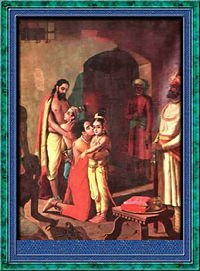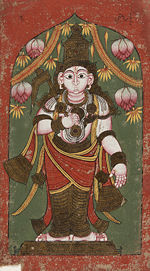Difference between revisions of "Balarama" - New World Encyclopedia
m (moved image) |
|||
| Line 21: | Line 21: | ||
'''Obv:''' Indian god Balarama-[[Sankarshana]], wearing an ornate headress, earrings, sword in sheath, holding a mace in his right hand and a plow-symbol in the left. Greek legend: BASILEOS AGATOKLEOUS "Of King Agathocles". | '''Obv:''' Indian god Balarama-[[Sankarshana]], wearing an ornate headress, earrings, sword in sheath, holding a mace in his right hand and a plow-symbol in the left. Greek legend: BASILEOS AGATOKLEOUS "Of King Agathocles". | ||
<br>'''Rev:''' Indian god [[Vasudeva]]-[[Krishna]], with ornate headdress, earrings, sword in sheath, holding [[kunda]] (pear-shaped vase) and [[chakra]] (wheel). [[Brahmi]] legend: RAJANE AGATHUKLAYASA "King Agathocles".]] | <br>'''Rev:''' Indian god [[Vasudeva]]-[[Krishna]], with ornate headdress, earrings, sword in sheath, holding [[kunda]] (pear-shaped vase) and [[chakra]] (wheel). [[Brahmi]] legend: RAJANE AGATHUKLAYASA "King Agathocles".]] | ||
| − | |||
| − | |||
One day, [[Vasudeva|Nanda Maharaja]] requested [[Gargamuni]], the family priest to visit their home in order to give names to Krishna and Balarama. When Gargamuni arrived at his house Nanda Maharaja, received him very well and then requested him to perform the naming ceremony. Gargamuni then reminded Nanda Maharaja that [[Kamsa]] was looking for the son of Devaki and said that if he performed the ceremony very opulently it would come to the notice of Kamsa, who would then suspect that Krishna was the son of Devaki. Nanda Maharaja therefore asked Gargamuni to perform the ceremony in secret, and Gargamuni did so giving the reasons for Balarama's names as follows: | One day, [[Vasudeva|Nanda Maharaja]] requested [[Gargamuni]], the family priest to visit their home in order to give names to Krishna and Balarama. When Gargamuni arrived at his house Nanda Maharaja, received him very well and then requested him to perform the naming ceremony. Gargamuni then reminded Nanda Maharaja that [[Kamsa]] was looking for the son of Devaki and said that if he performed the ceremony very opulently it would come to the notice of Kamsa, who would then suspect that Krishna was the son of Devaki. Nanda Maharaja therefore asked Gargamuni to perform the ceremony in secret, and Gargamuni did so giving the reasons for Balarama's names as follows: | ||
| Line 42: | Line 40: | ||
==Significance== | ==Significance== | ||
| + | |||
| + | [[Image:Krishna_Balarama.jpg|thumb|left|200px|Krishna-Balarama [[murti|deities]] at the Krishna-Balarama [[Temple]] in [[Vrindavan]]]] | ||
[[Gaudiya Vaishnavas]] believe that Balarama is the Supreme Personality of Godhead himself. He is worshipped as equal in supremacy to Krishna, yet wherever [[Krishna]] appears, Baladeva appears as Krishna's brother, sometimes elder, sometimes younger. Balarama is constantly serving Krishna in every respect in all of Krishna's incarnations and manifestations. In [[Rama]]-lila, Balarama serves [[Ramachandra]] as his younger Brother, [[Lakshmana]] and in the current age (Kali-[[yuga]]), Balarama spreads the '[[Sankirtan]] movement' of [[Chaitanya Mahaprabhu]] as his close friend [[Nityananda]]. | [[Gaudiya Vaishnavas]] believe that Balarama is the Supreme Personality of Godhead himself. He is worshipped as equal in supremacy to Krishna, yet wherever [[Krishna]] appears, Baladeva appears as Krishna's brother, sometimes elder, sometimes younger. Balarama is constantly serving Krishna in every respect in all of Krishna's incarnations and manifestations. In [[Rama]]-lila, Balarama serves [[Ramachandra]] as his younger Brother, [[Lakshmana]] and in the current age (Kali-[[yuga]]), Balarama spreads the '[[Sankirtan]] movement' of [[Chaitanya Mahaprabhu]] as his close friend [[Nityananda]]. | ||
Revision as of 18:02, 7 June 2007
Balarama (बलराम) (phonetically Balarāma), also known as Baladeva, Balabhadra and Halayudha, is the elder brother of the divine being, Krishna from the Puranic texts of Hinduism. Within Vaishnavism and a number of South Indian, Hindu traditions Balarama is worshipped as an avatar of Vishnu, and he is also listed as such in the Bhagavata Purana[1]. Within both the Vaishnava traditions and Hinduism generally he is acknowledged as being a manifestation of Shesha, the divine serpent on whom Vishnu rests.
Balarama in the Context of the Avatar Doctrine

The Bhagavata Purana describes Krishna as the original supreme divinity from whom everything else emanates. As part of this divine 'emanation', Krishna's very first expansion is Balarama, and from Balarama all other incarnations of God then appear. Since both Krishna and Balarama are sons of Vishnu, they are often considered a joint incarnation, and so Balarama is sometimes considered an avatar, that is, a genuine appearance of the divine in the realm of material existence. Although Scriptural lists of these ten divine manifestations frequently differ, the most commonly accepted dasavataras are 1) Matsya, a fish; 2) Kurma, a turtle; 3) Varaha, a boar; 4) Narasingha, a lion-man; 5) Vamana, a dwarf; 6) Parasurama, Rama with an axe; 7) Rama, a noble man; 8) Krishna, the teacher of the Bhagavadgita; 9) Buddha, a spiritually enlightened being and finally 10) Kalkin, who has yet to arrive. Some sects substitue Balarama for Rama as the seventh avatar.
Mythology
Balarama took birth as the son of Vasudeva and Devaki. Kamsa, the brother of Devaki and an evil king, was intent upon killing all the progeny of his sister because of a prediction that he would die at the hands of her eighth son. Kamsa thus threw his sister Devaki and her husband Vasudeva into prison, and proceeded to kill each of their children as soon as they were born.
In due course of time, Devaki became pregnant for the seventh time. However, this child was not destined to meet the fate of the six previous infants. The unborn child was miraculously transferred from Devaki's womb to the womb of Rohini, who had desired a child of her own. Thus Balarama's other name is also Sankarsana which describes the transfer of the child from the womb. The child was formally named Rama, but because of his great strength he was called Balarama (Strong Rama).
Thus, Rohini actually gave birth to Balarama and raised him. Balarama spent his childhood as a cowherd boy with his brother Krishna and friends. He later married Revati, the daughter of King Raivata, ruler of the Anarta province.
Obv: Indian god Balarama-Sankarshana, wearing an ornate headress, earrings, sword in sheath, holding a mace in his right hand and a plow-symbol in the left. Greek legend: BASILEOS AGATOKLEOUS "Of King Agathocles".
Rev: Indian god Vasudeva-Krishna, with ornate headdress, earrings, sword in sheath, holding kunda (pear-shaped vase) and chakra (wheel). Brahmi legend: RAJANE AGATHUKLAYASA "King Agathocles".
One day, Nanda Maharaja requested Gargamuni, the family priest to visit their home in order to give names to Krishna and Balarama. When Gargamuni arrived at his house Nanda Maharaja, received him very well and then requested him to perform the naming ceremony. Gargamuni then reminded Nanda Maharaja that Kamsa was looking for the son of Devaki and said that if he performed the ceremony very opulently it would come to the notice of Kamsa, who would then suspect that Krishna was the son of Devaki. Nanda Maharaja therefore asked Gargamuni to perform the ceremony in secret, and Gargamuni did so giving the reasons for Balarama's names as follows:
"Because Balarama, the son of Rohini, increases the transcendental bliss of others, His name is Rama, and because of His extraordinary strength, He is called Baladeva. He attracts the Yadus to follow His instructions, and therefore His name is Sankarshana." Bhagavata Purana 10.8.12
Balarama famously taught both Duryodhana of the Kauravas and Bhima of the Pandavas the art of fighting with a mace. When war broke between the Kauravas and the Pandavas, Balarama was equally affectionate to both parties and so decided to be neutral. Eventually when Bhima (of greater strength) defeated Duryodhana (of greater skill) by dealing a blow below the navel with his mace, Balarama threatened to kill Bhima. This was only prevented when Krishna reminded Balarama of Bhima's vow to kill Duryodhana by crushing the very thigh he exposed to his wife Draupadi.
In the Bhagavata Purana it is described that after Balarama took part in the battle that caused the destruction of the rest of the Yadu dynasty, and after he witnessed the disappearance of Krishna, he then sat down in a meditative state and departed from this world by producing a great white snake from his mouth, and thus he was carried by Sesha in the form of a serpent.
Depiction
Balarama is almost always depicted as being fair skinned, especially in comparison to his brother, Krishna, who is shown as dark blue or black in hue. His weapons are the plough and the mace. Traditionally Balarama wears blue garments and a garland of forest flowers. His hair is tied in a topknot and he has earrings, bracelets and armlets. Balarama is described as being very physically strong, in fact 'bala' in Sanskrit refers to 'strength'. Baladeva is famous as being Krishna's dearest friend.
Quotations regarding Balarama
- "Lord Balarama is the original Vishnu; therefore anyone remembering these pastimes of Lord Balarama in the morning and the evening will certainly become a great devotee of the Supreme Personality of Godhead, and thus his life will become successful in all respects." - A.C. Bhaktivedanta Swami Prabhupada
- "The splendor of Lord Balarama's transcendental form eclipses many millions of glistening rising moons, and the slightest scent of His boundless strength is sufficient to destroy many armies of demons." - From Appreciating Sri Vrindavana Dhama, pg. 111
Significance
Gaudiya Vaishnavas believe that Balarama is the Supreme Personality of Godhead himself. He is worshipped as equal in supremacy to Krishna, yet wherever Krishna appears, Baladeva appears as Krishna's brother, sometimes elder, sometimes younger. Balarama is constantly serving Krishna in every respect in all of Krishna's incarnations and manifestations. In Rama-lila, Balarama serves Ramachandra as his younger Brother, Lakshmana and in the current age (Kali-yuga), Balarama spreads the 'Sankirtan movement' of Chaitanya Mahaprabhu as his close friend Nityananda.
The only theological difference between Krishna and Balarama is that the bodily hue of Krishna is dark and that of Balarama is fair. Krishna is the Creator, and Balarama is his creative potency, but they are both worshipped as the Supreme Primeval Lord. Of the three transcendental elements (sat, cit and ananda), Balarama is in charge of sat (Sanskrit: eternity or truth). Hence he worshiped as the supreme teacher or adiguru.
Notes
- ↑ Bhag-P 1.3.23 "In the nineteenth and twentieth incarnations, the Lord advented Himself as Lord Balarama and Lord Krishna"
ReferencesISBN links support NWE through referral fees
- Bassuk, Daniel E. Incarnation in Hinduism and Christianity: the myth of the god-man. Atlantic Highlands, NJ: Humanities Press International, 1987. ISBN 0391034529
- Mitchell, A.G. Hindu Gods and Goddesses. London: Her Majesty's Stationery Office, 1982. ISBN 011290372X
- Parrinder, Geoffrey. Avatar and incarnation: the Wilde lectures in natural and comparative religion in the University of Oxford. London: Faber, 1970. ISBN 0571093191
See also
- Lakshmana
- Nityananda
- Shesha
External links
- Who is Lord Balarama (Overview)
- 1000 names of Lord Balarama
- Vedic Encyclopedia - Sri Balarama's Pilgrimage
- Balarama avatar - Bhagavata Purana
- Krishna-Balarama Temple
- Krishna & Balarama Deity Gallery - Vrindavan.com
- Krishna & Balarama Deity Gallery - Vrindavan-dham.com
Credits
New World Encyclopedia writers and editors rewrote and completed the Wikipedia article in accordance with New World Encyclopedia standards. This article abides by terms of the Creative Commons CC-by-sa 3.0 License (CC-by-sa), which may be used and disseminated with proper attribution. Credit is due under the terms of this license that can reference both the New World Encyclopedia contributors and the selfless volunteer contributors of the Wikimedia Foundation. To cite this article click here for a list of acceptable citing formats.The history of earlier contributions by wikipedians is accessible to researchers here:
The history of this article since it was imported to New World Encyclopedia:
Note: Some restrictions may apply to use of individual images which are separately licensed.
